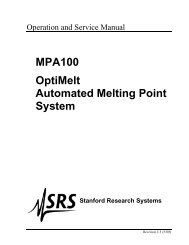DS335 Synthesized Function Generator
DS335 Synthesized Function Generator
DS335 Synthesized Function Generator
Create successful ePaper yourself
Turn your PDF publications into a flip-book with our unique Google optimized e-Paper software.
4-8 Performance Tests<br />
PERFORMANCE TESTS<br />
These tests are intended to measure the <strong>DS335</strong>'s conformance to its published specifications. The test<br />
results may be recorded on the test sheet at the end of this section. Allow the <strong>DS335</strong> at least 1/2 hour to<br />
warm up, run the <strong>DS335</strong>'s self test procedure, and proceed with the tests.<br />
FREQUENCY ACCURACY<br />
This test measures the accuracy of the <strong>DS335</strong>'s frequency. If the frequency<br />
is out of specification the <strong>DS335</strong>'s timebase frequency should be adjusted<br />
(see CALIBRATION section).<br />
Tolerance: ± 50 ppm of selected frequency<br />
1) Turn the <strong>DS335</strong> on and allow it to warm up for at least 1/2 hour. Set the<br />
<strong>DS335</strong> for sine wave, 1 MHz, 1 Vpp, and 50Ω Load Impedance.<br />
2) Attach the output of the <strong>DS335</strong> to the frequency counter. Terminate into<br />
50Ω. Attach the reference frequency input of the counter to the<br />
frequency standard. Set the counter for a 1s frequency measurement.<br />
3) The counter should read 1MHz ± 50Hz. Record the result.<br />
AMPLITUDE ACCURACY<br />
Frequency < 100 kHz<br />
The following tests measure the accuracy of the <strong>DS335</strong> output amplitude.<br />
There are separate tests for sine, square, and ramp/triangle. The tests<br />
measure the accuracy of the amplitude as a function of frequency. The sine<br />
wave test also measures the performance of the attenuators. There is only a<br />
single test for triangle and ramp functions because they have the same<br />
signal path.<br />
Connect the <strong>DS335</strong> output to the voltmeter through the 50Ω terminator. After<br />
the <strong>DS335</strong> has had at least 1/2 hour to warm up, perform the following tests.<br />
Sine Wave<br />
specification: ±0.1 dB (±1.2%)<br />
1) Set the <strong>DS335</strong> to sine wave, 100Hz, 3.54 Vrms (10Vpp), and 50Ω Load<br />
Impedance.<br />
2) Read the AC voltage on the voltmeter. Repeat at 1kHz and 10kHz, and<br />
100 kHz. The readings should be between 3.498 and 3.582 Vrms<br />
(±1.2%) Record the results.<br />
3) Set the <strong>DS335</strong> to 1 kHz. Set the amplitude to 1 Vrms. Read the<br />
voltmeter and record the results. The amplitude should be between<br />
0.988 and 1.012 Vrms. Repeat at 0.5 Vrms, 0.25 Vrms, 120 mVrms, 70<br />
mVrms, 40 mVrms, and 20 mVrms. Record the results. They should be<br />
within ±1.2% of the set values.<br />
Square Wave<br />
specification: ±1.2%<br />
1) Set the <strong>DS335</strong> to square wave, 100Hz, 5Vrms (10 Vpp), and 50Ω Load<br />
Impedance.<br />
<strong>DS335</strong> <strong>Synthesized</strong> <strong>Function</strong> <strong>Generator</strong>

















